(4TH INFANTRY DIVISION) IN THE HURTGEN FOREST,
GERMANY, 16-22 NOVEMBER 1944
(RHINELAND CAMPAIGN)
By Lieutenant Colonel James W. Haley
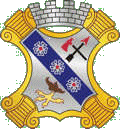
THE BATTALION REORGANIZATION - 18 NOVEMBER
On the morning of 18 November, the Regimental Commander arrived at the 2nd Battalion Command Post in the village of Bend for a conference. As a result of this meeting the Battalion Commander was relieved from command and returned to the Regimental Command Post with the Regimental Commander. Command of the Battalion was taken over at this time by Major George L. Mabry, Jr., the Executive Officer, and Captain James W. Haley was transferred from the 1st Battalion to the 2nd Battalion and assigned as Executive Officer. Captain Haley reported to the Battalion on the afternoon of 18 November and was immediately acquainted with the situation by the Battalion Commander. 43
When Major Mabry was given the command of the Battalion on the morning of 18 November, he was told to be prepared to attack the following day. For a new commander of a badly depleted and beaten battalion this was a large order.
Time was at a premium so the work began immediately. About 200 replacements had reported to the Battalion early in the morning and had been assigned to the companies. Unfortunately there were few officers among these new men. Clean clothes were issued to the troops and hot meals were served, lost and damaged weapons and equipment were replaced, and new platoon and squad leaders were appointed.
At the end of the day the Battalion had been reorganized but only to the extent of appointing new leaders and increasing the numerical strength. The Battalion was now about forty percent under strength in enlisted man and there were an average of two officers per company, except for Battalion Headquarters Company. 44
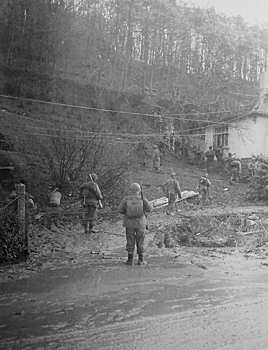
A column of GIs of the 8th IR/4th Inf.Div. ascends a hill and enters the Laufenburger forest.
(Lamersiefen / Joaswerk, south of Schevenhütte).
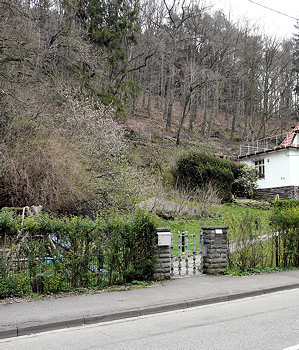
The same spot today.
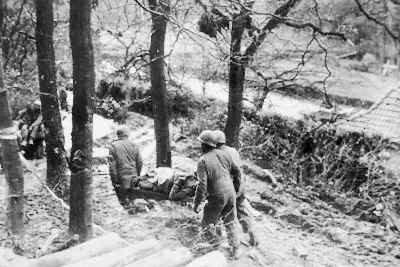
Litter bearers carrying a wounded soldier.
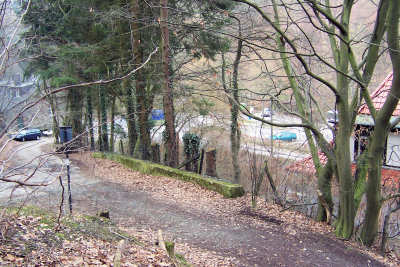
The same spot today.
(Lamersiefen / Joaswerk, south of Schevenhütte)
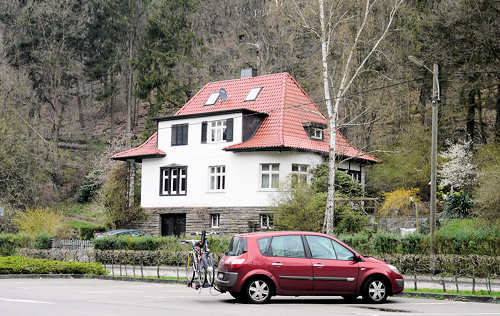
House as in photos above.
BATTALION PLAN OF ATTACK - 19 NOVEMBER
The Battalion plan of attack for 19 November was based on the hope of gaining surprise. No artillery or mortar preparations were to be made and it was hoped that the attention of the enemy would be drawn to the attack of the 3rd Battalion which was continuing its attack started on 18 November. The attack was to be made on the right flank of the regimental zone (See Map D) and the formation was to be a column of companies in the order of G, F and H Companies. The heavy machine gun platoons from H Company were to be attached to G and F Companies and these platoons were to follow the advance of the companies since no positions for supporting fire were available. The 81 mm platoon was to be prepared to support the attack on call from the same positions used for the 16 November attack which were still occupied. A wire team from the Battalion Wire Section was to accompany the advance of G Company laying a wire line as the advance proceeded. This wire line, on which the Battalion Commander and his Command Group could tap in, was to supplement the radios. The Battalion Commander and his Command Group, made up of himself, the S-3, the Artillery Liaison Officer and necessary runners and communications personnel, were to follow the advance of G Company. The attack was to cross the line of departure at 0800 which meant that the Battalion would have to move from the assembly area at 0630. The line of departure was to be the road running along the bottom of the ravine. Again it would be necessary to supply the companies from this road forward by hand carry and the Ammunition and Pioneer Platoon was alerted for this mission. Weapons carriers would be able to move along the road in the ravine but only under the cover of darkness. And again a forward collecting point was to be established by the Battalion Medical Section since the Battalion Aid Station was to remain in its present location in Bend as was the Battalion Command Post. The attached tank platoon was to remain in battalion reserve in its present location and the engineer platoon was to clear the trail running east from the line of departure along the stream as the attack progressed. (See Map D) 45

